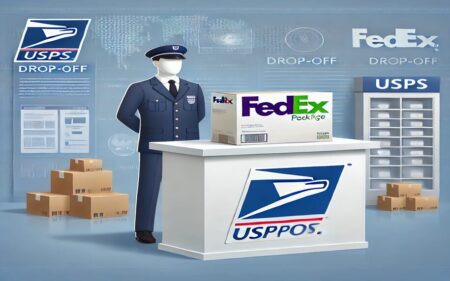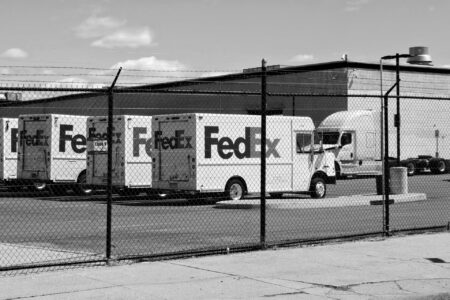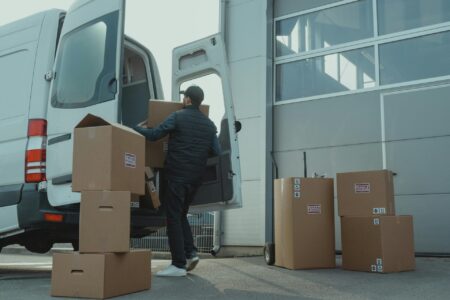When you’re waiting for an international package, you might see the status “Item Present to Import Customs” pop up on your tracking information. Don’t worry – this is a normal part of shipping items across borders. It simply means your package has arrived at the customs office in the destination country and is waiting to be checked.
This status is like a checkpoint in your package’s journey. It’s good news because it means your item has made it to the right country. But it also means there might be a bit of a wait while customs officials do their job.
In this article, we’ll break down what this status really means, why it’s important, and what you can expect to happen next. We’ll also share some tips on how to make sure your package gets through customs as smoothly as possible.
“Item Present to Import Customs” means your package has arrived at the customs office in the destination country and is awaiting inspection and clearance. It’s a normal part of international shipping and doesn’t necessarily indicate any problems. The package will be checked for compliance with import regulations and may be subject to duties or taxes before it can continue its journey.
Why Is This Status Important for International Shipping?
The “Item Present to Import Customs” status is, without a doubt, a key moment in the international shipping process. It’s the point where your package transitions from being in transit to being under the scrutiny of customs authorities. This stage can make or break the smooth delivery of your shipment.
For businesses engaged in international trade, this status is particularly significant. It can impact supply chains, delivery timelines, and ultimately, customer satisfaction. As well as indicating progress, this status also serves as a heads-up that potential delays or additional costs might be on the horizon.
Major carriers use this phrase to be upfront about delays that may be beyond their control, such as customs inspections. This status lets you know progress has been made, but further advancement may be stalled for a while. In other words, it’s a way for shipping companies to keep you in the loop about your package’s journey.
According to the World Customs Organization, customs authorities play a crucial role in facilitating legitimate trade while ensuring compliance with national laws and regulations. Source: World Customs Organization.
What Happens During the Customs Inspection Process?
When your item is presented to import customs, it kicks off a series of procedures designed to ensure compliance with the destination country’s import regulations. Here’s what typically happens:
- Document Review: Customs officials examine the paperwork accompanying your shipment. This includes the commercial invoice, packing list, and any required permits or certificates.
- Classification and Valuation: The goods are classified according to the Harmonized System (HS) code, and their value is assessed for duty calculation.
- Physical Inspection: Depending on various factors, your package may undergo a physical examination. This could range from a quick scan to a detailed inspection of the contents.
- Duty and Tax Assessment: Based on the classification and value, customs calculates any applicable duties and taxes.
- Clearance Decision: Finally, customs decides whether to clear the shipment or hold it for further action.
It’s worth noting that the complexity of this process can vary significantly depending on the nature of the goods and the specific regulations of the importing country.
How Does Customs Calculate Import Duties and Taxes?
The calculation of import duties and taxes is, to put it mildly, a complex affair. Customs authorities consider several factors when determining the amount you’ll need to pay:
- Tariff Classification: Every product is assigned a specific code under the Harmonized System. This code determines the duty rate.
- Customs Value: This is typically based on the transaction value, which is the price actually paid or payable for the goods.
- Country of Origin: Some countries have preferential trade agreements that may result in lower or zero duties.
- Nature of Import: Whether the import is for commercial or personal use can affect the duty rate.
Here’s a simplified example of how duties might be calculated:
| Factor | Value |
|---|---|
| Item Value | $1000 |
| Duty Rate | 5% |
| VAT/Sales Tax | 20% |
| Calculation | ($1000 * 5%) + ($1000 * 20%) |
| Total Duties and Taxes | $250 |
It’s important to remember that this is a basic example, and actual calculations can be much more complex. In addition to these factors, there might be additional fees for specific types of goods or services provided by customs.
What Happens During the Customs Inspection Process?
When your item is presented to import customs, it kicks off a series of procedures designed to ensure compliance with the destination country’s import regulations. Here’s what typically happens:
- Document Review: Customs officials examine the paperwork accompanying your shipment. This includes the commercial invoice, packing list, and any required permits or certificates.
- Classification and Valuation: The goods are classified according to the Harmonized System (HS) code, and their value is assessed for duty calculation.
- Physical Inspection: Depending on various factors, your package may undergo a physical examination. This could range from a quick scan to a detailed inspection of the contents.
- Duty and Tax Assessment: Based on the classification and value, customs calculates any applicable duties and taxes.
- Clearance Decision: Finally, customs decides whether to clear the shipment or hold it for further action.
It’s worth noting that the complexity of this process can vary significantly depending on the nature of the goods and the specific regulations of the importing country.
What Are Common Reasons for Customs Delays?
While we’d all love for our shipments to sail through customs without a hitch, the reality is that delays are not uncommon. Here are some of the most frequent causes of customs holdups:
- Incomplete or Inaccurate Documentation: This is, hands down, the most common reason for customs delays. Missing or incorrect information on your commercial invoice or packing list can lead to extended processing times. If clearance data is needed, the shipper will be contacted, which can cause significant delays.
- Restricted or Prohibited Items: If your shipment contains items that are restricted or prohibited in the destination country, it will likely face delays or even rejection.
- High-Value Goods: Shipments of high-value items often undergo more rigorous inspection, which can lead to longer processing times.
- Random Inspections: Customs authorities may select shipments for random, detailed inspections as part of their security measures.
- Peak Seasons: During busy periods, such as holidays, customs offices may experience backlogs, leading to longer processing times.
- Delays & Backlog in Customs: It’s important to understand that the “Item Presented to Import Customs” status doesn’t mean inspectors have the package in hand yet. It’s just been added to the queue of shipments waiting to be inspected. This queue can be quite long during busy periods.
- Taxes or Customs Duties: If customs duty and tax payments are overdue, the recipient will be informed. The shipment will remain in this status until the required payments are made.
As a rule of thumb, the key to avoiding these delays is preparation and attention to detail in your customs documentation.
How Does the “Item Presented to Import Customs” Update Work?
The “Item Presented to Import Customs” update is typically triggered when your package physically arrives at the customs facility in the destination country. Here’s a breakdown of how this process usually unfolds:
- Arrival Notification: The shipping carrier notifies customs that your package has arrived.
- Initial Screening: Customs conducts an initial screening of the shipment information.
- Status Update: The tracking system is updated to show “Item Presented to Import Customs”.
- Customs Processing: Your package enters the queue for customs processing.
- Further Updates: Depending on the outcome of customs processing, you may see additional status updates such as “Cleared Customs” or “Held for Inspection”.
- Customs Clearance Complete: After the item clears customs, you’ll receive a “Customs Clearance Processing Complete” notification. At this point, the shipment will be handed over to the carrier in the destination country to continue its journey.
It’s worth noting that the time between the “Presented to Customs” status and the next update can vary widely, from a few hours to several days, depending on various factors.
In summary, “Item Presented to Import Customs” is a routine status update, not a sign of trouble. It’s simply part of the normal international shipping process. Nevertheless, it’s always a good idea to keep an eye on your tracking information to ensure proper handling and take any needed action if required.
What Are the Consequences of Inaccurate Customs Declarations?
Inaccurate customs declarations can lead to a whole host of problems, ranging from minor inconveniences to serious legal issues. Here are some potential consequences:
- Delays: Inaccuracies often lead to additional scrutiny, causing delays in clearance.
- Fines and Penalties: Customs authorities may impose fines for incorrect declarations, even if they’re unintentional.
- Seizure of Goods: In severe cases, customs may seize your shipment if they suspect deliberate misdeclaration.
- Legal Consequences: Serious violations can result in legal action, including criminal charges in extreme cases.
- Increased Future Scrutiny: A history of inaccurate declarations may lead to more frequent inspections of your future shipments.
According to the U.S. Customs and Border Protection, penalties for customs violations can be severe, potentially reaching up to the domestic value of the merchandise. Source: U.S. Customs and Border Protection
How Does the “Item Presented to Import Customs” Update Work?
The “Item Presented to Import Customs” update is typically triggered when your package physically arrives at the customs facility in the destination country. Here’s a breakdown of how this process usually unfolds:
- Arrival Notification: The shipping carrier notifies customs that your package has arrived.
- Initial Screening: Customs conducts an initial screening of the shipment information.
- Status Update: The tracking system is updated to show “Item Presented to Import Customs”.
- Customs Processing: Your package enters the queue for customs processing.
- Further Updates: Depending on the outcome of customs processing, you may see additional status updates such as “Cleared Customs” or “Held for Inspection”.
It’s worth noting that the time between the “Presented to Customs” status and the next update can vary widely, from a few hours to several days, depending on various factors.
How Do I Know If My Shipment Has Been Inspected by Customs?
Customs authorities don’t always share detailed information about their processes, making it tricky to determine if they’ve inspected your shipment. However, you can look out for these indicators:
- Check your tracking updates for mentions of inspection or completion of customs review.
- Watch for extended delays in the “Item Presented to Import Customs” status, which may signal a thorough inspection.
- Look for “Customs Hold” or similar statuses in your tracking information, indicating inspection or need for additional details.
- Examine your package upon arrival for customs tape, opened packaging, or included inspection notices.
- Be aware that customs officials might contact you or your shipping company directly if they need more information for inspection.
Remember, customs agencies often use x-ray technology and risk assessment algorithms to screen packages without physically opening them.
What Should You Do If Your Shipment Is Delayed at Customs?
If your shipment seems to be stuck in customs limbo, don’t panic. Here are some steps you can take:
- Check the Tracking Information: Sometimes, additional details about the delay may be available in the tracking information.
- Contact the Shipping Company: They may have more information or be able to inquire with customs on your behalf.
- Prepare Documentation: If customs requires additional information, have all relevant documentation ready.
- Be Patient: Customs processes can take time, especially during busy periods.
- Consider a Customs Broker: For complex issues, a customs broker can help navigate the clearance process.
Remember, in most cases, delays are temporary, and your shipment will be cleared once all requirements are met.
How Can I Track the Status of My Shipment Through Customs?
Keep tabs on your package and anticipate potential issues by tracking your shipment through customs. Here’s how you can do it:
- Use the Carrier’s Tracking Tool: Major carriers offer online tracking tools that provide updates on your shipment’s status, including customs-related information.
- Sign Up for Notifications: Opt for email or SMS alerts from shipping companies to receive status change notifications, especially useful for customs updates.
- Check Customs Websites: Some countries provide online tools where you can enter your shipment’s reference number to track its customs status.
- Use Third-Party Tracking Apps: Download apps or visit websites that compile tracking information from multiple carriers, particularly helpful if different companies handle your shipment.
- Contact Your Shipping Company: Don’t hesitate to reach out to your shipping company’s customer service for more detailed information.
- Consult with a Customs Broker: If you’re working with a customs broker, ask them for detailed updates on the customs clearance process.
While you might not receive minute-by-minute updates during customs processing, these methods will help you stay informed about significant status changes. Remember, the level of detail available may vary depending on the country and specific customs procedures involved.
Are There Fees Associated with Customs Clearance?
In short, yes. Customs clearance often involves various fees, which can include:
- Import Duties: Taxes imposed on imported goods.
- Customs Processing Fees: Charges for the handling and processing of your shipment.
- Value Added Tax (VAT) or Sales Tax: Depending on the country and value of goods.
- Storage Fees: If your package is held for an extended period.
- Inspection Fees: For any physical inspections conducted.
The exact fees can vary widely depending on the country, type of goods, and value of your shipment. It’s always a good idea to research potential costs beforehand to avoid surprises.
Key takeaways:
- “Item Present to Import Customs” means your package has arrived at the destination country’s customs office for inspection and clearance.
- This status is a normal part of international shipping and doesn’t necessarily indicate problems.
- Customs officials review documentation, classify goods, assess duties and taxes, and conduct physical inspections.
- Common reasons for customs delays include incomplete documentation, restricted items, unpaid duties, and random inspections.
- To ensure smooth customs clearance, provide accurate documentation, understand import regulations, and consider using a customs broker for complex shipments.
- Track your shipment using carrier tools, customs websites, or third-party apps to stay informed about its status.
- Be prepared for potential fees associated with customs clearance, including import duties, processing fees, and taxes.
- If your shipment is stuck in customs, check tracking information, contact the shipping company, and have all relevant documentation ready.
- Inaccurate customs declarations can lead to delays, fines, seizure of goods, and legal consequences.
- While you can’t always determine if your package has been inspected, look for extended delays, customs hold statuses, or physical signs of inspection upon delivery.












Leave a Reply